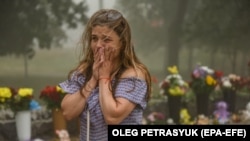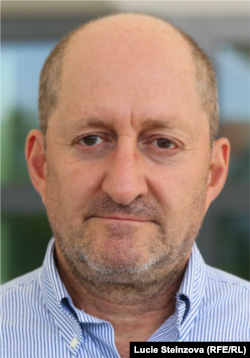Historic developments mounted as Sweden and Finland prepared to join NATO and Russia defaulted on its foreign debt for the first time since 1918. Meanwhile, Ukraine drove Russian forces off Snake Island in the Black Sea, while Russian missile strikes hit a shopping mall in Kremenchuk and an apartment building in the Odesa region, killing numerous civilians far from the front lines.
Despite the Snake Island setback and the Russian military’s slow progress in deadly fighting in the Donbas more than four months after the February 24 invasion, President Vladimir Putin still “wants to take most of Ukraine," the U.S. intelligence chief said.
Here are some of the key developments in Russia over the past week and some of the takeaways going forward.
Thin Ice
When Emmanuel Macron spoke to Putin four days before the large-scale invasion of Ukraine, trying to talk him down from the brink and set up a meeting with U.S. President Joe Biden, the Russian president showed signs of impatience.
“Listen to me carefully. Do you hear me? I will repeat again,” Putin said at one point in the conversation, according to a transcript published by French media. Then, toward the end, when Macron was seeking to get him to commit to talks with Biden, Putin suggested he had better things to do than make arrangements for such a meeting.
“To be honest with you, I wanted to go play ice hockey. I am speaking to you from the arena…. I will call my advisers first.”
It’s no wonder, perhaps, that Putin preferred to play hockey than to talk about war and efforts to avoid it: Even though he learned to skate late in life -- about 11 years ago -- he always seems to be on the winning side when he hits the ice, often scoring numerous goals on the way to victory.
Plus, by the time he spoke to Macron, Putin may have already made up his mind to launch the invasion -- a day after the call, he hinted as much in a bellicose address that people who have been watching Putin for decades found deeply disturbing, and the meeting with Biden never materialized.
At that point, in any case, Putin apparently believed victory in Ukraine would be as easy to achieve as victory in a friendly hockey match on Red Square.
It was not.
By all accounts except those of Russian officials, Putin expected that the Russian military would effectively seize control in Kyiv within a few days of the February 24 invasion, with Ukrainian President Volodymyr Zelenskiy fleeing, surrendering, or at the very least making major concessions to Moscow’s demands.
Facts On The Ground
Instead, Ukrainian forces beat back the Russian advance on the capital, driving them out of the north after several weeks of fighting. And while Russia has seized cities in the south including Kherson and Mariupol, which it razed with bombs, rockets, and artillery shells in the process, its forces are continuing to suffer major losses in fierce fighting as they struggle to achieve what is now the closest thing to a stated goal of the assault: control over the Donetsk and Luhansk oblasts, the southeastern region known as the Donbas.
On June 30, Ukraine said it had forced Russian troops off Snake Island in the Black Sea, a focus of attention – and the subject of a meme that’s now on T-shirts, mugs, and even a postage stamp -- since Russian forces attacked and captured it shortly after the invasion began.
The Russian Defense Ministry called the retreat a “gesture of goodwill,” an assertion that was mocked by many, and analysts said the development was meaningful, particularly with Russia compromising global food security by blockading Ukrainian ports and impeding the export of grain from one of the world’s largest producers.
“Ukraine’s expulsion of Russian forces from Snake Island is a significant accomplishment for Kyiv and an important defeat for Russia,” Mason Clark, senior analyst at the Washington-based Institute for the Study of War, said in an e-mailed statement.
“Russia needed Snake Island to threaten the sea route to Odesa along the Romanian coast, which is the safest way for ships to skirt the Russian blockade of Ukrainian grain and other exports,” he said.
As for Russia’s confrontation with the West, which is closely intertwined with the war in Ukraine even though U.S. and NATO forces are not fighting in it, the situation as it stands on July 1 may be drastically different from what Putin imagined it would be on the morning of February 24, when Russian missiles began striking targets across Ukraine.
He may have thought NATO would be on its way to acceding to his demand for a binding pledge that it would never make Ukraine, Georgia, or any other former Soviet republic beyond the Baltic states a member, and that the alliance would be scaling back forces in countries close to Russia.
NATO Goes North
Instead, NATO is now set to grow bigger, with Sweden and Finland -- which shares a long border and a long history with Russia -- formally invited into the alliance on June 30 at a summit in Madrid. They may be members by the end of the year.
Also, a rapid reaction force that now numbers 40,000 troops – many of them now located near Russia’s border -- will expand to 300,000. And while in 2010 Moscow and NATO stated that neither posed a threat to the other, at this summit the alliance declared Russia the "most significant and direct threat” to the peace and security of NATO members.
The momentous NATO meeting came a week after the European Union made Ukraine and Moldova candidates for EU membership.
At least publicly, Putin has shrugged off the EU move. And analysts say he may not be too concerned about Sweden and Finland joining NATO, in part because he will harness it to bolster one of the chief narratives that he uses to maintain support at home -- the notion that Russia is under a growing threat from the West, which is determined to weaken and even destroy it.
The invasion has resulted in tougher Western sanctions on Russia and its increasing isolation, as U.S. and European companies withdraw just over three decades after the country opened up during the collapse of the Soviet Union. The Russian economy may shrink by double digits this year, and the government defaulted on its foreign debt for the first time since 1918.
Despite all that, Putin’s main aim in the unprovoked invasion -- the subjugation of large parts of Ukraine, including Kyiv -- does not seem to have changed much.
"We continue to be in a position where we look at President Putin and we think he has effectively the same political goals that he had previously, which is to say that he wants to take most of Ukraine," U.S. Director of National Intelligence Avril Haines said on June 29.
The outlook in the war remains "pretty grim," Haines said, describing the most likely near-term scenario as a grinding conflict in which Russian forces make incremental gains and neither side achieves a big breakthrough.
Desire And Reality
The disconnect between Putin’s goals and the situation on the battlefield -- what Russians call the difference between “desire and reality” -- has made for a vicious circle that may only spiral further for the foreseeable future: After failing to achieve a quick victory, Russia immediately turned to tactics, methods, and actions that have deepened its isolation, united Ukrainians, and increased solidarity in the West as outrage mounts.
Around Kyiv and Chernihiv in the north, retreating Russian forces left a trail of evidence of war crimes as survivors describe summary executions, rape, and other atrocities during the brief period of occupation.
In the southeast, the devastated city of Mariupol is for many, in the 21st century, an almost unbelievably stark symbol of unprovoked and needless death, pain, and suffering. In a report released on June 30, Amnesty International said evidence suggests that Russian air strikes that killed hundreds of people deliberately targeted a theater being used as a shelter in the besieged city in March.
And as leaders of the Group of Seven (G7) major democracies were meeting in Germany on June 27, a Russian missile strike hit a crowded mall in Kremenchuk, a city far from the front lines, causing a fire and killing at least 20 people and wounding more than 50.
"Indiscriminate attacks on innocent civilians constitute a war crime," the G7 leaders said in a statement, condemning the “abominable” strike on the shopping center.
In cities across Russia, Ukraine, and the rest of the former Soviet Union, malls are one of the signs of the normalcy that has crept back into those countries following the collapse of communism: centers where one goes to shop, see a movie, meet friends -- all with the assumption that a place so predictable could not be very dangerous.
That assumption was horrifyingly wrong on March 25, 2018, a week after Putin’s election to a fourth term, when a fire engulfed a mall in the Russian city of Kemerovo, at least 60 people including children trapped in a smoke-choked movie theater -- an avoidable tragedy whose toll was exacerbated by the corruption and negligence that critics of Putin say has worsened over his nearly 23 years as president or prime minister.
It was wrong again in Kremenchuk, Ukraine, four years later – and this time, there was no doubt who was to blame.
With the death toll still expected to rise in Kremenchuk, Russian missiles struck civilians again overnight on June 30-July 1, this time hitting an apartment building and a recreation center in the Odesa region, in what may have been retaliation for the loss of Snake Island, which is relatively nearby.
As of around midday on July 1, Ukrainian authorities said 18 people were confirmed dead.








